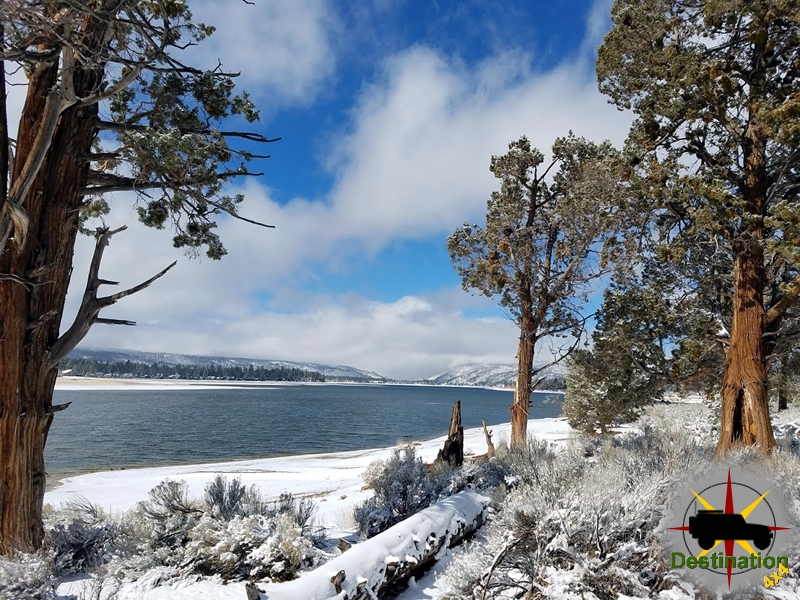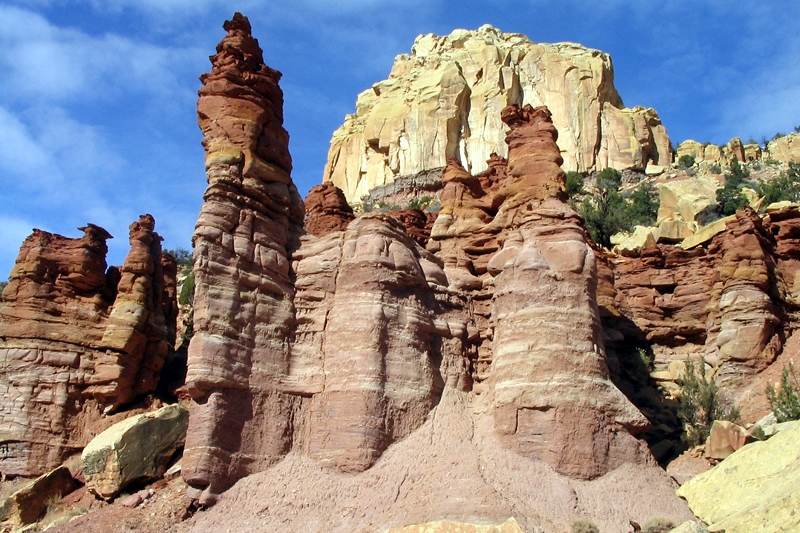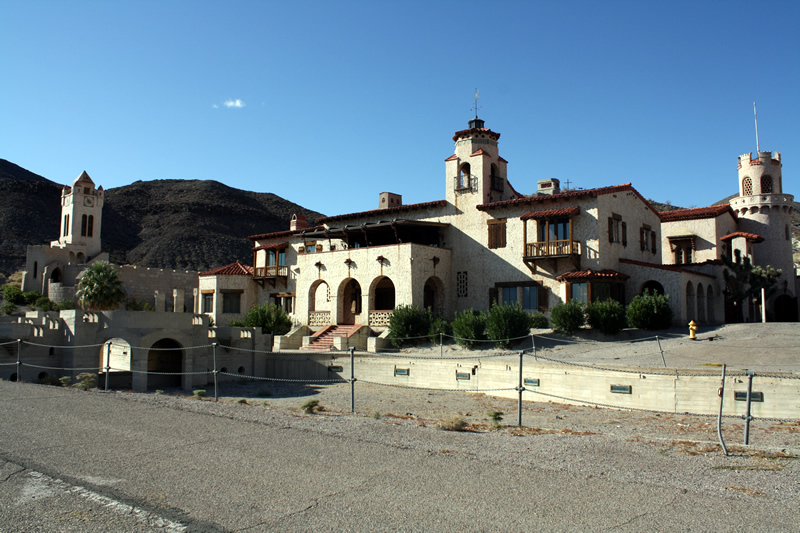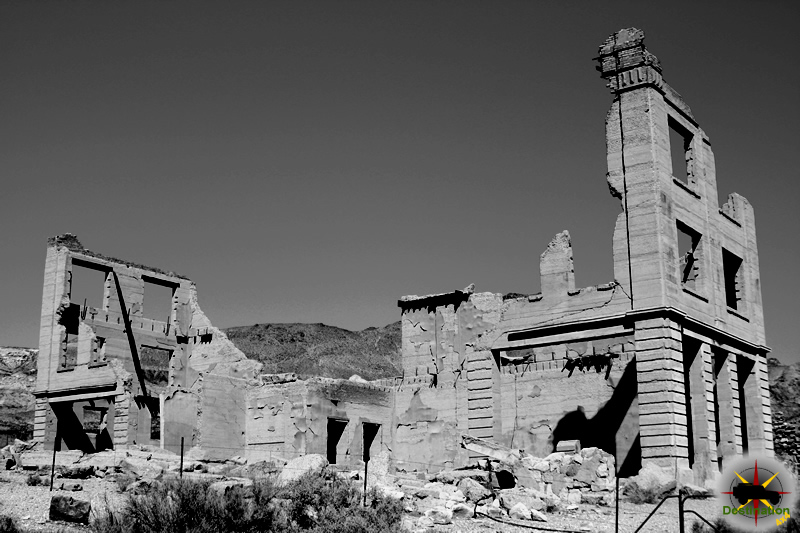
Kelso Depot
The story of the westward expansion is the story of the railroads. Beginning in 1862, the Union Pacific Railroad sought expansion opportunities along the western coast of the United States. To secure a foothold into California the railroads must cross the Mojave Desert and the depot in Kelso was crucial to accomplish this goal. Located at the junction of Kelbaker Road and the Kelso Cima Road, the Kelso Depot stands in testimony of the technological progress of the nations trains.

August of 1900, Montana Senator William A. Clark invested in a small Los Angeles based railway which would become the San Pedro, Los Angeles & Salt Lake Railroad. In 1902, in mine owner made a deal to sell half of the stock to the Union Pacific even before the railway was completed.

In 1905, after 235 miles of track are laid, three warehouse men placed their names in a hat and drew out the winner John Kelso, for whom track siding #16 of the Salt Lake route was named. Later in 1905, Kelso was just one depot along the Salt Lake Route which now stretched from San Pedro, CA to Salt Lake City Utah. This new route opened southern California to the Union Pacific Railroad. In 1921, Union Pacific convinced Senator Clark to sell his remaining shares.
Additionally, in 1905 Senator Clark divested himself of some land in southern Nevada along another rail stop. This auction is considered the birth of Las Vegas, and Clark Country was named for the man.

Built in 1921, The Kelso Depot is architecturally styled as a Mission Revival and just one of several depots along the route which were designated as division points and provided facilities for operations and maintenance purposes. The buildings original design included a telegraph office, conductor’s room, baggage room, staff dormitories, a billiard room, library and locker. The spring water in the nearby Providence mountains allowed the location to service the steam engines. Additionally, the relatively steep 2% 2000 foot grade necessitated the use of helper engines by the steam locomotives of the day to crest the Kessler Summit.
Other depot locations
- Lynndyl, Utah
- Milford, Utah
- Las Vegas, Nevada
- Caliente, Nevada
- Yermo, California
- San Bernardino, California
Union Pacific continued to operate the depot from 1921 to 1985. The depot provided much need infrastructure during World War 2, at which point the facility started a long decline in utility. Diesel engines improved efficiency and duration allowed the Union Pacific railroad to reduce their personnel requirements. The 1960’s introduced the second generation of more powerful and efficient diesel engines which eliminated the need for the helper engines. Combined with the cessation of passenger travel in August, 1964 the Kelso depot is destined to languish on the back roads of history. The Kelso Depot ceased operations as a train depot in 1962.
The Kelso Depot is currently in use as a Visitors Center of the Mojave National Preserve.
Kelso Depot Trail Map
References
Doc Holliday – Death Announcement by the Denver Republican

Doc Holliday, born John Henry Holliday, died on November 8, 1887, at the age of 36 in Glenwood Springs, Colorado. A dentist turned gambler and gunslinger, he suffered from tuberculosis for much of his life, which progressively worsened. By 1887, his health had deteriorated significantly, and he sought relief in the mineral springs of Glenwood Springs, hoping the warm waters might ease his condition. However, the disease, combined with his heavy drinking and frail state, led to his death in a sanatorium. Legend has it that his final words, upon looking at his bare feet and realizing he wasn’t dying in a gunfight, were, “This is funny.” He was buried in Linwood Cemetery overlooking Glenwood Springs.
News of Doc Holliday death was reported on November 10, 1887, by the Denver Republican.
Now a Sleeper
Doc Holliday is dead. Few men have known better known to a certain class of sporting people and few men of his character had more friends or stronger champions. He represented a class of men who are fast disappearing the New West. He had the reputation of being a bunco-man, desperado and bad man generally. yet he was a very mild mannered man; was genial and companionable, and had many excellent qualities. In Arizona he was associated with the Wyatt Earp gang. These men were officers of the law, and were opposed to the ’‘rustlers” or cattle thieves. Holliday killed several men during his life in Arizona his body was full of wounds received in bloody encounters. His history was an interesting one. He was sometimes in the right, but quite often in the wrong, probably, in his various escapades.
The Doctor only had one deadly encounter in Colorado, and this was in Leadviile. He was well known in Denver and had lived here a good deal in the past few years. He had strong friends in some old-time detective officers and in certain representatives of the sporting element. He was a rather good looking man and his coolness and courage, his affable ways fund of interesting experiences, won him many admirers. He was a strong friend, a cool and determined enemy and a man of quite strong character. He has been well known to all the States and Territories west of Kentucky, which was his old home. His death took place at Glenwood Springs Tuesday morning.
Denver Republican.
Wide Hollow Campground
Nestled within the stunning Escalante Petrified Forest State Park in southern Utah, Wide Hollow Campground beckons adventurers, families, and nature enthusiasts to an idyllic retreat where ancient geology meets serene waters. Perched at approximately 5,900 feet elevation along the shores of the 130-acre Wide Hollow Reservoir—just a short drive west of the charming town of Escalante off Scenic Byway 12—this campground offers a perfect base for exploring the dramatic landscapes of Grand Staircase-Escalante National Monument. Imagine awakening to the golden hues of sunrise reflecting off the reservoir’s clear blue waters, with the rugged silhouettes of distant canyons and the Kaiparowits Plateau framing your view. The area, part of Utah’s “Swell” region, is a geologic treasure trove shaped by millions of years of erosion, where slot canyons, natural arches, and expansive vistas create a playground for outdoor pursuits. Here, the air is crisp and invigorating, the nights starlit and quiet, and the days filled with the symphony of birdsong from raptors, songbirds, and waterfowl that frequent the shores.
Natural Features and the Surrounding Area
Wide Hollow Campground is enveloped by the park’s signature attractions, blending aquatic serenity with terrestrial marvels. The reservoir itself is a highlight, stocked year-round with rainbow trout, largemouth bass, and bluegill, making it a prime spot for shore fishing or casting from a rented canoe, kayak, or paddleboard—rentals available on-site during warmer months (March to November). Its calm, swimmable waters invite lazy afternoons lounging on the sandy beach, while the adjacent petrified forest showcases nature’s artistry: colorful, mineralized logs in kaleidoscopic shades of red, orange, yellow, and purple, remnants of ancient trees fossilized over 150 million years ago. Easy-access hiking trails, like the 1-mile Petrified Forest Loop, wind through these formations, offering interpretive signs that reveal the area’s rich paleontological history amid blooming wildflowers in spring or golden cottonwoods in fall. Beyond the park, the broader Escalante region unfolds into endless adventures—hike slot canyons, horseback ride through desert washes, or stargaze in one of the darkest skies in the U.S. The elevation provides cooler summers and mild winters, though visitors should prepare for high-desert conditions with plenty of sun and minimal rainfall.
Available Facilities
Designed for comfort without sacrificing the rustic charm of camping, Wide Hollow Campground features modern amenities to enhance your stay. The park offers 29 full-hookup sites across its loops (including the adjacent Lake View Campground), accommodating tents, RVs, and trailers up to 40 feet. Each site includes a shaded shelter, picnic table, fire pit with grate, paved parking, and ample space for privacy—many boast premium reservoir views toward Escalante’s iconic canyons and Powell Point. Electrical hookups range from 20 to 50 amps, with potable water and sewer connections at every site; additional frost-free water spigots are scattered throughout for convenience.
Supporting facilities keep things clean and convenient:
- Restrooms and Showers: Modern, well-maintained buildings with hot, free showers—spacious and family-friendly, though occasional upkeep notes from visitors highlight their general cleanliness.
- Group Areas: A dedicated group pavilion and lakeside overflow spots for larger gatherings (up to 8 people per standard site).
- Water Recreation: Boat ramp for easy launches, plus canoe/kayak/paddleboard rentals.
- Day-Use Amenities: Picnic areas with shelters, a swimming beach, and an RV dump station (additional fee applies).
- Essentials: Drinking water fill-ups, firewood sales (harvested locally to prevent invasive species), and a small camp store for basics. Generators are not permitted in the campground to preserve the peaceful ambiance, but quiet hours are strictly enforced.
Reservations are recommended year-round via Utah State Parks’ online system, with fees starting at $16 per night for basic sites (including park entry). Pets are welcome on leashes, and the campground remains open all year, though services like rentals may vary seasonally. Whether you’re toasting marshmallows by the fire ring or embarking on a dawn paddle, Wide Hollow Campground delivers an unforgettable blend of comfort, recreation, and raw natural beauty—your ideal launchpad for Utah’s red-rock wonders.
White House Campground
Nestled in the rugged southwestern expanse of Utah’s Grand Staircase-Escalante National Monument (GSENM), White House Campground offers a serene, primitive escape for adventurers seeking solitude amid one of America’s most remote and geologically stunning landscapes. Established in 1996 and spanning nearly 1.9 million acres, GSENM—often called a “frontier for the 21st century”—protects a vast mosaic of five life zones, from sun-scorched desert lowlands to high-elevation coniferous forests. This unspoiled wilderness, jointly managed by the Bureau of Land Management (BLM), is a living museum of natural and cultural history, where ancient Anasazi and Fremont peoples left rock art, granaries, and occupation sites dating back to AD 950–1100. The monument’s dramatic “staircase” of colorful rock layers—limestones atop sandstones atop shales—has been sculpted over millions of years by wind, water, and time, revealing slot canyons, towering cliffs, badlands, plateaus, hoodoos, arches, and natural bridges. Bordered by Glen Canyon National Recreation Area to the east, Bryce Canyon National Park to the north, and Capitol Reef National Park to the northeast, GSENM invites quiet exploration, scientific discovery, and immersive outdoor pursuits like hiking, backpacking, off-roading, photography, and wildlife viewing. Its biological diversity supports desert bighorn sheep, peregrine falcons, and endemic plants, while paleontological treasures, including dinosaur fossils, underscore its role as a hotspot for geologists and paleontologists.
Perched at the monument’s southern edge, White House Campground embodies this raw beauty in a broad, open valley framed by the Paria River to the north and striking white-grey sandstone buttes to the south. Just two miles south of Highway 89 and the Paria Contact Station (about 43 miles east of Kanab, Utah), it serves as an ideal staging point for journeys into the adjacent Paria Canyon-Vermilion Cliffs Wilderness—a jointly managed area renowned for its narrow slot canyons, petrified wood, archaeological sites, and world-class hikes like the iconic Buckskin Gulch and Wire Pass trails. Here, the air carries the scent of sagebrush and juniper, and sunsets paint the buttes in hues of crimson and gold, offering stargazers unobstructed views of the Milky Way in this International Dark Sky Park. The site’s proximity to Zion National Park (about 80 miles west) and Bryce Canyon (roughly 100 miles north) makes it a perfect hub for multi-park itineraries, while local trails provide day hikes through colorful badlands teeming with desert wildlife, from coyotes to golden eagles.
Available Facilities
White House Campground is designed for low-impact, backcountry-style camping, emphasizing harmony with the desert environment. It’s a first-come, first-served site (no reservations required), open year-round, with a small nightly fee that supports monument maintenance. Facilities are basic to preserve the area’s pristine character:
| Facility | Details |
|---|---|
| Sites | 7 car-accessible sites for tents or small RVs (no hookups; suitable for vehicles up to 20 feet); 5 walk-in tent-only sites (short carry-in from parking). All sites include picnic tables, fire rings, and tent pads for comfort. |
| Restrooms | Vault toilets (non-flush, cleaned regularly) for basic sanitation. |
| Water | No potable water on-site—bring your own or fill up at the nearby Paria Contact Station (seasonal). Practice Leave No Trace principles to protect scarce resources. |
| Firewood & Grills | Fire rings provided; gather dead wood locally or bring your own (no cutting live trees). Propane stoves recommended during fire restrictions. |
| Accessibility | Mostly flat, gravel sites; suitable for most abilities, but walk-in sites require light gear hauling over uneven terrain. |
| Other Amenities | Trash receptacles available; pack out all waste. No electricity, showers, or dump stations—embrace the off-grid vibe. Nearby Paria Contact Station offers maps, permits, and info for wilderness entry. |
With only 12 sites total, the campground rarely feels crowded, fostering a peaceful retreat even during peak seasons (spring and fall). Arrive early to secure a spot, and note that high-clearance vehicles are advised for the final gravel stretch of Monument Road 751.
Whether you’re a seasoned backpacker plotting a multi-day trek or a family chasing golden-hour photos, White House Campground delivers an authentic taste of GSENM’s timeless allure. Pack your sense of wonder, respect the fragile ecosystem, and let the monument’s ancient whispers guide your adventure. For current conditions or permits, stop by a GSENM visitor center—your journey into this geological masterpiece awaits.
References
Rhyolite Train Depot
The town of Rhyolite boasted three train services using the Rhyolite Train Depot which is completed in June, 1908. The depot services the Las Vegas & Tonopah, the Tonopah & Tidewater and the Bullfrog-Goldfield train services. The Las Vegas & Tonopah Railroad started its push to Rhyolite by laying one mile of track per day. Later, the railroad redoubled its efforts and pushed two miles per day its its bid to connect the booming two of Rhyolite with the outside world.

The first train entered Rhyolite at 7:00 pm on December 14th, 1906 bringing another 100 people into the town. Train service to the booming mining town was a big deal. The fact that Rhyolite could lure three train services all but ensured the future of the largest mining town in the state.
In 1907, the Las Vegas & Tidewater line alone hauled 50 freight cars per day into Rhyolite. This volume required a large depot to handle the load. In September 1907, the construction of the depot started by the Las Vegas & Tidewater Railroad. The Mission Revival styled building in constructed with concrete blocks built upon a solid concrete foundation. A gentlemen’s waiting area is located in the east end and a separate ladies waiting room is located in the west end. The ticket office is located in the center of the building and the ticket agents office is located on the second floor.
The train depot takes up an entire city block on Golden Street. The cost on construction was $130,000, or about $3.8 million in 2021.





The train depot in Rhyolite is complete in June 1908. The timing of the complete is ironic in that it coincided with the beginning on the decline of Rhyolite. Within months of completion of the depot, more people were leaving town using the station than arriving. In the first year of operation, the railroad generated a small profit. Between 1909 and 1919 the railroads lost money each year. By 1919, the railroads cut their losses and salvaged the tracks for other projects.
Rhyolite Ghost Casino
The 1920’s offered a brief revival to the town on Rhyolite. Wes Moreland purchase the train depot in 1935 and opened the Rhyolite Ghost Casino in 1937. Drinking and gambling are available on the first floor. The second floor operates as a brothel. The star of World Ware 2 halts the brief rebirth of Rhyolite. The fuel rationing almost completely drained the economy in the area.
In the 1960’s Moreland sister inherited the train depot. Mrs. Herschel Heiser operated a museum and gift shop out of the old station.
At the time it was built, the train depit is claimed to be “The finest in the state.” Today, the train station is one of the best preserved.
Rhyolite Trail Depot Map
Rhyolite Train Depot Marker Text
In keeping with its prominence as a mining center, Rhyolite was serviced by three railroads: the Las Vegas & Tonopah, the Tonopah & Tidewater, and the Bullfrog-Goldfield.
The Las Vegas & Tonopah Railroad laid one mile of track per day, then two miles of track per day, in its hurry to connect Rhyolite with the outside world. The first train from the Las Vegas & Tonopah entered Rhyolite at 7 p.m. on December 14, 1906, with about 100 passengers.
It was a big deal for a young mining town to be serviced by one railroad, but three railroads were almost unheard of in the history of Nevada. With three railroads, it seemed that Rhyolite was destined to be the largest mining camp in the state and the first few boom years made this prediction look inevitable.
By 1907, the Las Vegas & Tonopah alone was hauling 50 freight cars into town per day. The large volume of freight required a large depot to handle it.
In September 1907, the Las Vegas & Tonopah began building the depot that stands before you. It is constructed of concrete block with a solid concrete foundation in the Mission Revival style. There was a gentlemen’s waiting area on the east end and a ladies’ waiting room on the west end. A separate baggage room was located east of the men’s waiting area. The ticket office was located in the center of the building, and the ticket agent’s quarters were located upstairs.
It was planned to take an entire city block on Golden Street and cost approximately $130,000 – the equivalent of $3,798,393 in 2021.
The Las Vegas & Tonopah Railroad Depot was completed in June 1908, around the same time that Rhyolite began its slow decline. Within months of its completion, more people were leaving Rhyolite through the depot than were arriving.
The railroad turned a small profit in 1908 but lost money every following year until it was finally dismantled in 1919. The tracks were salvaged, but the depot was left to stand as one of the few remaining buildings from the Rhyolite boom, primarily because it could not be moved elsewhere.In the 1920s, Rhyolite enjoyed a small revival through tourism. Wes Moreland bought the depot in 1935 and, beginning in 1937, operated it as the Rhyolite Ghost Casino. The drinking and gaming were conducted downstairs, while a different type of hospitality, reportedly staffed by “working women,” was conducted upstairs in the old ticket agent’s quarters.
Like the town before it, the casino had a relatively short life. The onset of World War II, and the associated Rhyolite Train Depot Markerwar effort, including fuel rationing, completely drained the area’s economy.
By the 1960s, the building had passed to Moreland’s sister, Mrs. Herschel Heisler, who operated the lower floor as a museum and gift shop for tourists.Since the 1930s, the depot has passed from person to person, eventually ending up with the Barrick Mining Company.
In October 2000, the Bureau of Land Management (BLM) acquired the depot, along with most of the Rhyolite Townsite, from the mining company in a land swap.At some time before the swap, a group of local citizens replaced the historic depot roof with modern composite shingles. Although not historically accurate, the shingles have helped preserve the building in the relatively good condition that you see today.
At the time the depot was built, the local newspaper claimed it was “the finest in the state.” Today, it is one of the best-preserved examples of early twentieth-century Mission Revival train depots in Nevada.
The BLM’s Tonopah Field Office is working to restore this historic building. If you would like to donate to the restoration, a secure donation box is located to your right. All donations will be used in Rhyolite.
Please help us keep the depot in its current condition. Report acts of vandalism to the Tonopah Field Office at (775) 482-7800.



